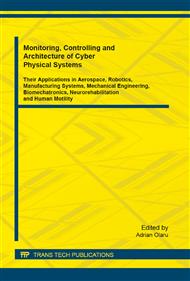[1]
Kawalec M., Fizyczne i technologiczne zagadnienia przy obróbce z małymi grubościami warstwy skrawanej. (Physical and Technological Issues in Machining with Small Thicknesses of Cutting Layer - in polish), Wydawnictwo Politechniki Poznańskiej, Poznań. Rozprawy nr 106, (1979).
Google Scholar
[2]
Kawalec M. Skrawanie hartowanych stali i zeliwa narzedziami o okreslonej geometrii, (Cutting of Hardened Steel and Iron Cast using Tools, with a Particular Geometry, in polish) Wydawnictwo Politechniki Poznanskiej, Poznan, Rozprawy nr 234, (1990).
Google Scholar
[3]
W. Grzesik W., Podstawy skrawania materialow konstrukcyjnych. (Fundamentals of Cutting Constructions Materials – in polish). WNT Warszawa, (2011).
Google Scholar
[4]
Miko E., Konstytuowanie mikronierowności powierzchni metalowych obrobionych narzędziami o określonej stereometrii. (Constitution of Asperities Metal Surfaces Machined using Tools with Particular Stereometry – in polish), Wydawnictwo Politechniki Świętokrzyskiej. Kielce. Seria: Monografie, Studia, Rozprawy 46, (2006).
Google Scholar
[5]
Storch B., Zjawiska przykrawedziowe i monitorowanie chropowatosci powierzchni po obróbce jednoostrzowej. (Effect-edge and Monitoring of Surface Roughness after Single Edge Machining – in polish). Politechnika Koszalińska, Monografia Wydziału Mechanicznego nr 124, 2006, Koszalin.
Google Scholar
[6]
Z. Liu, Z. Shi, B. Yi. Wan, Definition and Determination of the Minimum Uncut Chip Thickness of Microcutting, International Journal of Advanced Manufacturing Technology, No 01, (2013); 1219-1232.
DOI: 10.1007/s00170-013-5109-4
Google Scholar
[7]
N. Ikawa, S. Shimada and H. Tanaka, Minimum Thickness of Cut in Micromachining. Nanotechnology vol. 3, (1992), 6-9.
DOI: 10.1088/0957-4484/3/1/002
Google Scholar
[8]
Z.J. Yuan, M. Zhou and S. Dong, Effect of Diamond Tool Sharpness on Minimum Cutting Thickness and Cutting Surface Integrity in Ultraprecision Machining. Journal of Materials Processing Technology, vol. 62, Issue 4, (1996), 327–330.
DOI: 10.1016/s0924-0136(96)02429-6
Google Scholar
[9]
X. Liu, R. E. DeVor and S.G. Kapoor, An Analytical Model for the Prediction of Minimum Chip Thickness in Micromachining. Journal of Manufacturing Science and Engineering, vol. 128, (2006), 474-481.
DOI: 10.1115/1.2162905
Google Scholar
[10]
T. Mikolajczyk, Niekonwencjonalny noz tokarski z odtwarzaniem własnosci skrawnych ostrza. (Unconventional Turning Tool with Restitution of Cutting Properties – in polish), Inzynieria i Aparatura Chemiczna, nr 5, (2012), 217-218.
Google Scholar
[11]
T. Mikolajczyk, Romanowski L., Optimisation of Single Edge Tools Exploitation Process, Applied Mechanics and Materials, vol. 332, (2013), 431-436.
DOI: 10.4028/www.scientific.net/amm.332.431
Google Scholar


